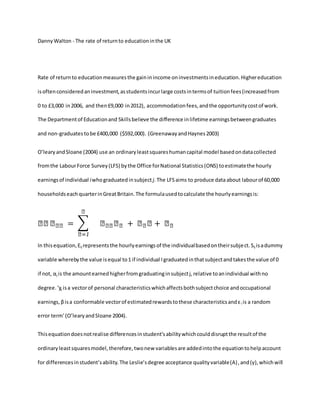
Rateofreturntoeducation.docx (1)
- 1. DannyWalton - The rate of returnto educationinthe UK Rate of returnto educationmeasuresthe gaininincome oninvestmentsineducation.Highereducation isoftenconsideredaninvestment,asstudentsincurlarge costsintermsof tuitionfees(increasedfrom 0 to £3,000 in2006, and then£9,000 in2012), accommodationfees,andthe opportunitycostof work. The Departmentof Educationand Skillsbelieve the difference inlifetime earningsbetweengraduates and non-graduatestobe £400,000 ($592,000). (GreenawayandHaynes2003) O’learyandSloane (2004) use an ordinaryleastsquareshumancapital model basedondatacollected fromthe LabourForce Survey(LFS) bythe Office forNational Statistics(ONS) toestimatethe hourly earningsof individual iwhograduatedinsubject j. The LFSaims to produce dataabout labourof 60,000 householdseachquarterinGreatBritain.The formulausedtocalculate the hourlyearningsis: 𝑙𝑙 𝑙 𝑙𝑙 = ∑ 𝑙 𝑙=1 𝑙 𝑙𝑙 𝑙 𝑙 + 𝑙 𝑙 𝑙 + 𝑙 𝑙 In thisequation,Eij representsthe hourlyearningsof the individualbasedontheirsubject.Sij isadummy variable wherebythe value isequal to1 if individual Igraduatedinthatsubjectandtakesthe value of 0 if not, αj is the amountearnedhigherfromgraduatinginsubjectj,relative toanindividual withno degree.‘χi isa vectorof personal characteristicswhichaffectsbothsubjectchoice andoccupational earnings,βisa conformable vectorof estimatedrewardstothese characteristicsandεi is a random error term’(O’learyandSloane 2004). Thisequationdoesnotrealise differencesinstudent’sabilitywhichcoulddisruptthe resultof the ordinaryleastsquaresmodel,therefore,twonew variablesare addedintothe equationtohelpaccount for differencesinstudent’sability.The Leslie’sdegree acceptance qualityvariable(A),and(γ),whichwill
- 2. representthe returntostudentability.The Leslie hypothesisisthatstudentswill selectsubjectsbased on difficultybasedontheirability.DatacollectedfromUCASapplicationswasusedtocalculate the value.Now,α will onlyreflectthe returntosubjectj basedonmarketforces.The new equationwiththe Leslie’sdegree acceptance qualityvariable is: 𝑙𝑙 𝑙 𝑙𝑙 = ∑ 𝑙 𝑙=1 𝑙 𝑙𝑙 𝑙 𝑙 + 𝑙 𝑙 𝑙 + 𝑙 𝑙 𝑙 + 𝑙 𝑙 Thisequationcanbe usedtocalculate the average future earningsof anindividualbasedontheir undergraduate degree subject.Basedondatacollectedbythe LFSbetween1994 and 2002, using informationfromapproximately17,500 malesand15,200 females,O’learyandSloane (2004) foundthat a male witha degree wouldenjoya113.76% increase inhourlyearningsthanamale withno qualifications,and131.56%. The increase inhourlyearningsformaleswithA-level standardeducation standsat 30.03% againsta male withnoqualifications,and25.33% for females.Findingdataaboutthe rate of returnto educationisimportantsothat studentscandecide whethertomake the investmentof highereducation,andwhetherthe increase inearningsoveranindividual’slifetime wouldbe greater than the cost of educationboththroughcost of living,costof tuition,andopportunitycostof missing out on3 years(UK) of paidwork.It is alsoimportantsothat studentscanbe encouragedtojoincertain degree subjectstoequibrilatethe supplyanddemandof labourwithindifferentmarkets,basedonthe differencesinearningseachsubjectreturns. The amount of male undergraduatesincreasedbyathird,and the amountof female undergraduates doubled,between1990/91 and 2000/01 (O’learyandSloane 2005), thismeansthat there isan increasingnumberof universityeducatedworkersjoiningthe labourforce eachyear.Giventhat graduatesgainso much fromhavinga universityeducation,the increase innumberof applicantsand therefore the increase insupplyof workerswithdegreesmayreduce the superiorwagespaidto
- 3. universitygraduates.Thishowevermaynotbe the case.There is evidence tosuggestthatwagesof graduateshas remainedrelativelyconstantWalkerandZhu(2003), whichcan onlybe explainedby demandforeducatedworkersmatchingthe increase insupply.Thisisthe case for the mostsubjects, but subjectssuchas maths& computing,engineering&technologyandarchitecture have seen significantincreasesinmedianearnings.Increasingreturnsinsome subjects,combinedwithdecreasing returnsinothersubjectssuchas social sciencesandarts will resultinconstantaggregate returnsto highereducation.Supplyanddemandshiftswill playacrucial role indeterminingwhichsubjectswill showincreasinganddecreasingreturns. The amount of newgraduatesthat take architecture increasedby44.86% between1994 and 2002 for males,and25.00% for females(O’learlyandSloane 2005).There is therefore anobviousincrease in supplyof architectures,whichwouldsuggestthatthe wage of architectureswouldfall relativelytothose withoutdegrees,butthere hasbeenasignificantrise inmedianwagesrelative tothose with2+A levels, 11.64% for males.The change insupplydoesnotconnectwiththe changesinwages.Thisisbecause of time lagsbetweenstudentstakingarchitecture andthe returninwagesinadultlife.Like anymarket, once suppliersrealise there are gainstobe made,theywill enterthe market,butthe difference intime betweenthe suppliers(students)realisingthatthere are gainsto be made from architecture degrees and those studentsrealisingthosegainscouldspan20 years.Hence whythe increase inrelativewages has increasedby11.64% between1994 and2002, but the no.of male studentstakingarchitecture has increasedbya muchhigheramount,almost45%. Rate of returnalsovariesbetweenregions,aswell aschoice of university.Returnstothose whoattend longestablishedinstitutionscanearnupto 11% more than those otherwise(O’learyandSloane 2006). Data showsthat inLondon,the nominal returnoneducationis20.7% per yearfor menand 22.2% (the highestinthe country) forwomencomparedtoan individualinthe westmidlandswith2+A-levels,and thisassumesthatduringstudygraduatesmade no income andincurred£3,000 pa tuitionfees(O’leary
- 4. and Sloane 2006). It it therefore obviousthatowningadegree inLondongivesthe highestreturns. Although,otherdatashowsthatthe difference indegree returnsrelativetoA-level qualificationsinthe same regionismuch lower,asmenonlymake a 1.5% increase and3.5% forfemales(the lowestinthe country)(O’lrearyandSloane 2006).Therefore,the wagesavailable inLondoncomparedtoother regionsare much higherhoweverthisdoesnotnecessarilydependonwhetherthe individual hasa degree.Inotherregionsthere isasignificantdifference inreturnsdependingonwhetherthe individual ownsa degree,sothe worthof owningadegree variesdependingonlocation. Sloane,PJ.O’Leary,NC.(2004) “The Returnto a UniversityEducationinGreatBritain” Sloane,PJ.O’Leary,NC.(2005) ”The ChangingWage Returnto an Undergraduate Education” Sloane,PJ.O’Leary,NC.(2006) ”Ratesof Returnsto DegreesacrossBritishRegions” Walker,I.AndZhu, Y. (2003) "Education,EarningsandProductivity:RecentUKEvidence",LabourMarket Trends,March, pp. 145-152. GreenawayD.and HaynesM.(2003) "FundingHigherEducationinthe UK: The Role of FeesandLoans", EconomicJournal,vol.113, pp.F150-F166